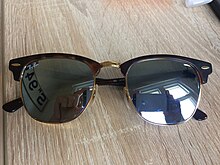Browline glasses


Browline glasses are a style of
Description
Browline glasses are constructed with the upper portion of the frame thicker than the lower, simulating eyebrows, or otherwise drawing attention to the wearer's natural brow line.
The most common means of construction is for the upper portion of the frame (the "brows" or "caps") and temples to be made of plastic, with the remainder of the frame (the bridge and eyewires, or "chassis") to be made of metal. The chassis inserts into the brows and is held in place by way of a series of screws. For a period in the 1960s, numerous models emerged in which the brows were constructed from aluminium; following the style's resurgence in the 2000s, browlines made wholly out of one type of metal with less pronounced brow portions became popular.
Monobrowlines
Monobrowlines are a variant of browlines in which the bridge is contiguous with the caps, creating a solid, unbroken line across the top of the frame. The style dates back to the Shuron Stag, a browline prototype, which enjoyed some brief popularity before being replaced by the Ronsir as Shuron's flagship frame. The original stag had no metal chassis: the lenses were mounted directly to the brow caps via two sets of screws. Although the style was never popular in the United States, it became particularly fashionable in Europe and England in the 1960s as part of Amor's Spotlite line. The modern monobrowline originated in the 1980s, as part of an effort by Bausch and Lomb to diversify their Ray-Ban sunglass collection with the Wayfarer Max, a fusion of the then-popular Wayfarer and Clubmaster sunglass models.[1][2] The style proved unpopular and was quickly phased out. The monobrowline design was resurrected by a variety of manufacturers in the 2010s (chiefly Oakley) after browlines returned to popularity. Unlike its tenure in the 1980s, monobrowlines proved to be a popular variant among eyeglass wearers in the 2010s.[2]
History
1940s–1960s
Browline glasses were introduced in 1947 by Jack Rohrbach, then vice-president of Shuron Ltd., an eyeglass company.
The style continued to rise in popularity throughout the 1950s, with different manufacturers modifying the original browline design. Art-Craft and Victory Optical introduced browlines with much lighter aluminum caps instead of plastic brows. Shuron began modifying the original browline shape, beginning with the rectangular "Rondon" model, to appeal to individuals of all face shapes. For a period in the 1950s, plastic brows designed to emulate wood grains became popular, with Victory Optical offering models that allowed wearers to fit different caps to coordinate with different clothing.
Browlines continued to remain popular through the 1960s, but less so as advances in plastics manufacturing offered even further frame customization via solid plastic eyeglasses, which could now be made in more shapes, sizes, and colors than in the past. Those who wished to wear plastic frames but still liked the browline style flocked to "plastic browlines," plastic glasses with transparent lower portions and solid upper portions, which became a major frame style of the 1960s.[1]
1970s–1990s

In 1971, Shuron sold their sixteen-millionth pair of Ronsirs.
In the mid-1980s, Bruce Willis wore a pair of Shuron Ronsirs with tinted lenses on the series Moonlighting, leading to a surge in demand for browline sunglasses. In response, Ray-Ban, which already dominated the sunglasses market with their Wayfarers and Aviator sunglasses, introduced the Clubmaster, a traditional browline frame with sunglass lenses, and the Wayfarer Max, a Wayfarer shaped-and-sized browline. The Clubmaster went on to become the third best selling sunglasses style of the 1980s, behind the Wayfarer and aviator.[1] Bob Geldof can also be seen wearing a pair of browline sunglasses that look to be Clubmasters in the 1982 Pink Floyd movie The Wall.
Browlines (and plastic glasses in general) were deeply affected by the backlash against the 1980s consumer culture, and carried a variety of stigmas during the 1990s, variously identifying the wearer as a nerd, geek, elderly, or a devotee of far-right politics; the 1993 film Falling Down in particular helped to cement an association between browlines and the "angry white male".[5]
2000s onwards
During the 2000s, browlines were still seen as overtly conformist or "nerdy" and were still associated with 1950s culture and fashion.
The influence of the television series
By 2013, of the major companies that produced browlines during the height of their popularity, only Shuron and Victory Optical still manufacture them. Shuron is the only company to have constantly produced browlines since their inception; Victory Optical shut down for a period in the 1980s-1990s before resuming manufacture in the 2000s.[8] Art-Craft optical still features the Clubman model on their webpage, although the company no longer manufactures the frame, and now only sells remaining parts from the factory. Ray-Ban still produces the Clubmaster.[9]
See also
References
- ^ a b c d e f Fassel, Preston. "Hindsight is 20/20: The Browline". The Optician's Handbook. Retrieved 2013-06-10.
- ^ a b Fassel, Preston (September 2014). "Coming up Around the Bend: Monobrowlines". Archived from the original on 2014-09-12. Retrieved 2014-09-12.
- ^ a b "Looking Back": an illustrated history of the American Ophthalmic Industry, by the Optical Laboratories Association
- ^ Art Craft Optical: History
- ^ a b Fassel, Preston. "Foster's Frames: The History and Mystery of D-FENS's Glasses". Retrieved 2013-06-11.
- ^ a b Shuron Ltd.: About Us
- ^ Shuron Ltd. / Shuron.com
- ^ Marfuggi, William. "Victory Heritage". Retrieved 2015-03-13.
- ^ Clubmaster ray-ban.com
